DART Publishes New Guidelines for Basal Cell, Squamous Cell Carcinoma
New guidelines for both cancer types provide detailed and distinct criteria for diagnoses, staging, use of IGRST, and follow up, among other areas.
According to the DART guidelines for both BCC and SCC, partial pathology reports, which are prone to sampling error, should be considered preliminary diagnoses.

The Dermatology Association of Radiation Therapy (DART) has published new clinical guidelines on noninvasive, radiation-based treatments for patients with basal cell carcinoma (BCC) and squamous cell carcinoma (SCC), according to a news release by DART.1
To assist dermatologists, radiation oncologists, and radiation therapists in appropriate treatment use, the new guidelines for the treatment of nonmelanoma skin cancers were collaboratively formed by DART education and research committee members. Additionally, these guidelines address appropriate use of image-guided superficial radiation therapy (IGSRT), which combines high-resolution dermal ultrasound imaging with superficial radiation therapy, for patients with BCC and SCC. Other detailed and distinct criteria include recommendations for diagnoses, staging, and follow up.
Emphasizing the central need for a multidisciplinary team (MDT) as part of treatment protocol, the guidelines affirm deliverance of IGSRT in the dermatology setting by a board-certified dermatologist and a radiation therapist under supervision of a prescribing dermatologist, as well as a radiation oncology and medical physicist. Additionally, an organized weekly national Grand Rounds to assist dermatologists with complex scenarios was recommended. Dose decay calculations, inverse square calculations, and review of beam parameters and field placement to determine whether the anatomic location of the current cancer overlaps with previously radiated fields were suggested for inclusion in Grand Rounds.
"We're absolutely committed to ensuring that all appropriate patients with nonmelanoma skin cancer have access to safe and effective, noninvasive, radiation-based treatments in the outpatient dermatology setting, and that those undergoing treatment receive quality care in accordance with the latest evidence-based research and best practice standards of care," Jacob Scott, MD, DPhil, DABR, president and chairman of DART, said in a news release on the publication of the guidelines.1 "When delivered in accordance with these evidence-based guidelines, IGSRT is shown to be safe and up to 99% effective at eradicating these cancers."
According to the DART guidelines for both BCC and SCC, partial pathology reports, which are prone to sampling error, should be considered preliminary diagnoses.2,3 High-resolution dermal ultrasound (HRDUS) imaging was recommended in addition to pathology reports, and images should be evaluated in the context of preliminary histologic diagnosis to determine if findings were confirmatory or revelatory. Confirmatory imaging indicates superficial BCC as well as SCC in situ vs nodular BCC for revelatory imaging.
Two methods were suggested for debulking BCC tumors with depth measurements greater than 2.0 mm. Those not located in cosmetically- or functionally- sensitive anatomic areas can be surgically debulked via shave removal or electrodessication and curettage (ED&C). Furthermore, those that are located in these sensitive anatomic areas can be debulked via hedgehog inhibitor (HHI) pre-treatment over the course of several months, with subsequent IGSRT treatment and intermittent HHI treatment given at a maximum of 3 weeks.
Similarly, shave removal and ED&C was recommended for SCC tumors not located in cosmetically- or functionally- sensitive anatomic areas. For those located in these sensitive anatomic areas, pre-treatment with PD-1 inhibitor cemiplimab (Libtayo) was recommended, with IGSRT occurring upon tumor reduction to 2.0 mm or smaller.
For treatment of both BCC and SCC tumors, 92% of patients undergoing IGRST exhibit measurable changes in invasion depth compared with that of previous image. The timing of pre-treatment measurements enables adaptive changes in treatment parameters; changes which are necessary in approximately 40% of cases to augment efficacy and minimize toxicities in patients.
Follow-up for both tumor types included a recommended wait time of 6 to 10 weeks after treatment conclusion and a follow-up evaluation including HRDUS imaging. If suspicion of a residual tumor is present, the recommendation is presentation of the case to MDT/Grand Rounds for potential boost dosage of treatment therapy.
References
- Dermatology Association of Radiation Therapy publishes new clinical guidelines for the treatment of nonmelanoma skin cancer. News release. Dermatology Association of Radiation Therapy. July 22, 2024. Accessed August 5, 2024. https://tinyurl.com/5fc52jyf
- Dermatology Association of Radiation Therapy. Appropriate use criteria for the treatment of basal cell carcinoma (BCC) using image-guided superficial radiation therapy (version 1.2024). Accessed August 5, 2024. https://tinyurl.com/muyz589u
- Dermatology Association of Radiation Therapy. Appropriate use criteria for the treatment of early-stage cutaneous squamous cell carcinoma (SCC) using image-guided superficial radiation therapy (version 1.2024). Accessed August 5, 2024. https://tinyurl.com/37s76s6h
Newsletter
Stay up to date on recent advances in the multidisciplinary approach to cancer.